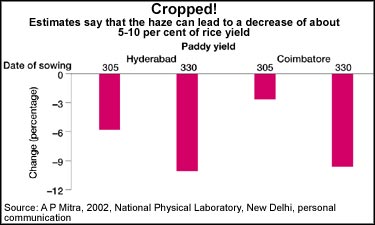Widespread web
 RAINFALL
RAINFALL
Aerosols may be reducing rainfall and threatening the Earth's fresh water supplies, according to the Scripps Institution of Oceanography, San Diego. "Initially we thought that aerosols were mainly a cooling agent, offsetting global warming. Now we find that these have a big impact on the water budget of the planet,' said Scripps professor V Ramanathan, in a study published in 2001 . Based on satellite data from nasa and indoex, scientists have found that tiny particles of soot and other pollutants are affecting the planet's hydrological cycle far more than previously understood. The indoex findings are limited, because they are restricted to the dry season, from December to April. Scientists want to now study how the solar heating in the haze affects the monsoon rainfall. But what they already know, should cause us to think hard.
While tiny particles suspended in the air are essential for cloud formation, if they are too many in number, it may adversely affect rainfall (see box: Heavy cloud). In polluted areas in Thailand and Indonesia, clouds do not precipitate due to very small droplet size, whereas they precipitate in less polluted areas within about 10 to 15 minutes after their formation.
According to the indoex models (gcm-fo and gcm-mo), the haze causes a 1-2 per cent decrease in tropical average evaporation and precipitation, depending on the season. Model simulations also show that the haze causes significant redistribution of rainfall in the indoex region. While some regions experience as much as 20-40 per cent increase, others suffer comparable decreases (see map: Changing pattern of rainfall). For instance, gcm-fo shows haze leading to a large increase in rainfall over southern India with a large decrease in winter rainfall over parts of northwest India, Pakistan and Afghanistan. Areas over the western equatorial Pacific are also getting dry.
Effect of particulates on cloud properties could also be influencing the arrival of monsoon and its distribution in India, according to Mitra.
"Observational evidence about decrease in the size of cloud droplets with increase in aerosol amount, and decrease in rainfall over the Sahelian region correlated with the increase in dust, show without doubt that aerosol has a strong influence on clouds and precipitation,' says A Jayaraman of Physical Research Laboratory, Ahmedabad, who has studied the effect of aerosols on monsoons. "If it can happen in other parts of the world why not over India? The problem is that we do not have observational evidence,' adds Jayaraman. "Some scientists may argue that the monsoon is such a strong system and nothing can happen to it. But we should not forget that our pollution is also equally strong.'
TEMPERATURE AND CLIMATE
In 1995, a report published by the Intergovernmental Panel on Climate Change (ipcc), an international body of scientists, recorded some aerosols as having a cooling effect. Since then understanding of aerosol impact have undergone a sea change. By 2001, ipcc had gathered enough evidence to support the case for aerosols having a warming effect. Warming due to black carbon aerosols may, in fact, balance the cooling effect of sulphate aerosols
Related Content
- State of the Climate in Asia 2024
- Order of the National Green Tribunal regarding large scale felling of toddy yielding palm trees in Bihar, 05/06/2025
- European State of the Climate Report 2024
- Learning Interrupted: Global Snapshot of Climate-Related School Disruptions in 2024
- E-bikes: charging toward compact cycling cities
- Regional overview of food security and nutrition in Africa 2023: statistics and trends
